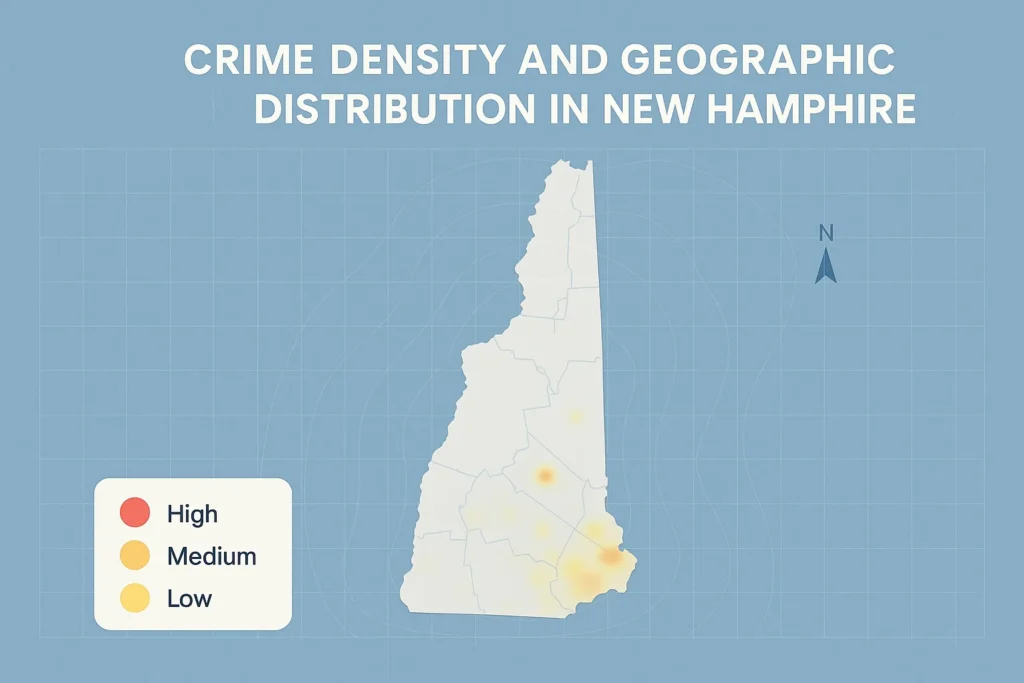New Hampshire Crime Rate 2025: In-Depth Analysis and Comparative Crime Statistics
Imagine living in a place where the streets feel safer and communities thrive with a sense of calm. This is true for New Hampshire, a state often noted for its low crime levels. Understanding how well this state performs when it comes to public safety and the responsibilities of law enforcement gives us insight into its unique landscape.
Crime here isn’t just about numbers but reflects deeper issues like social issues and the workings of the criminal justice system. When these elements come together, they paint a detailed picture of how justice is pursued and how effective legal action can be. Taking a closer look at both violent acts and property offenses helps reveal challenges and successes in maintaining a secure environment. Let’s dive into the facts and figures that shape our understanding of New Hampshire’s approach to criminology and safety.
- New Hampshire maintains some of the lowest crime rates in the U.S. relative to population size.
- Analyzing both violent and property crime provides a clearer understanding of public safety challenges.
- Crime statistics support law enforcement planning, public policy, and social justice efforts.

Comprehensive Crime Statistics for New Hampshire
When examining crime patterns in New Hampshire, data reveals that total crimes reported are under 14,000, showcasing a comparatively lower incidence than many other states. Within this, property crime makes up the majority of offenses, echoing national trends but with generally reduced frequency. Violent offenses, while serious, account for a small fraction of the overall crime load, highlighting effective safety measures in place.
These details from crime statistics present a valuable overview for both law enforcement and policymakers aiming to preserve and enhance public safety. Exploring the numbers gives us a solid foundation for understanding the balance between different types of crimes that impact communities.
- Total crimes reported are under 14,000, reflecting a lower incidence than many states.
- Violent crime accounts for approximately 10% of all crimes in the state.
- Property crime predominates crime reports, echoing national patterns but at lower rates.
| Crime Category | Total Cases Reported | Rate per 1,000 Residents |
|---|---|---|
| Total Crimes Reported | 13,966 | 9.96 |
| Violent Crime | 1,503 | 1.07 |
| Property Crime | 12,463 | 8.89 |
Detailed Violent Crime Breakdown

Diving deeper into violent crime categories within New Hampshire, we find a range of offenses including murder, rape, robbery, and assault. Among these, assault stands out as the most frequent violent crime, far outnumbering others. These patterns offer critical insight into the threats faced by residents and the focus areas for criminal justice efforts and legal action. The risk of becoming a victim here is quite low, roughly 1 in 933 residents, reflecting both preventive strategies and community resilience. Examining such breakdowns not only informs public understanding but supports tailored interventions by law enforcement and policymakers.
- Violent crimes in New Hampshire include murder, rape, robbery, and assault.
- Assault represents the most frequent violent crime type by a wide margin.
- Risk of violent crime victimization is roughly 1 in 933 residents.
| Violent Crime Type | Reported Cases | Rate per 1,000 Residents |
|---|---|---|
| Murder | 26 | 0.02 |
| Rape | 499 | 0.36 |
| Robbery | 225 | 0.16 |
| Assault | 753 | 0.54 |
Comparison of Violent Crime Rates: New Hampshire Versus National Median
Looking at violent crime rates in a nationwide context reveals how New Hampshire stands apart. Its violent crime rate is significantly lower than the national median, showcasing a safer environment comparatively. Particularly, the murder rate remains well below the national average, a testament to effective community and law enforcement efforts.
Similarly, both rape and robbery rates fall under their respective national medians, with assault cases also less frequent than those seen across the country. Such comparisons aid in understanding the state’s strengths while guiding continuous improvements in public safety and national security considerations. For further insights into national crime data, the FBI’s Uniform Crime Reporting program provides extensive resources.
- New Hampshire’s violent crime rate is substantially lower than the national median rate.
- Murder rate is notably below the national average, indicating relative safety.
- Rape and robbery rates also fall under the national medians, while assault is less prevalent than nationwide averages.
| Crime Type | New Hampshire Rate | National Median Rate |
|---|---|---|
| Violent Crime | 1.07 | 4.0 |
| Murder | 0.02 | 0.06 |
| Rape | 0.36 | 0.38 |
| Robbery | 0.16 | 0.67 |
| Assault | 0.54 | 2.64 |
Property Crime Analysis in New Hampshire

Within the crime landscape, property crime is the most common offense category in New Hampshire. The majority of these crimes involve theft, followed by less frequent but still meaningful occurrences of burglary and motor vehicle theft. These offenses represent important security challenges both at individual and community levels. Residents have roughly a 1 in 112 chance of experiencing some form of property crime, a reminder that vigilance and prevention remain essential. Recognizing which categories dominate helps allocate resources and build effective protection strategies to maintain the state’s reputation for safety.
- Property crime is the most prevalent crime type in New Hampshire, with theft as the leading subcategory.
- Burglary and motor vehicle theft are significantly less common but remain important security concerns.
- Individuals have about a 1 in 112 chance of experiencing property crime in the state.
| Property Crime Type | Reported Cases | Rate per 1,000 Residents |
|---|---|---|
| Burglary | 779 | 0.56 |
| Theft | 10,848 | 7.74 |
| Motor Vehicle Theft | 836 | 0.60 |
Comparing Property Crime Rates: New Hampshire vs U.S. Median
When comparing property crime rates, New Hampshire consistently reports numbers well below the national medians. This finding highlights a relatively lower level of criminal activity concerning burglary, theft, and motor vehicle theft. In fact, burglary and vehicle theft rates sit at less than half the national median, pointing to robust preventive measures and community vigilance. Meanwhile, incidents of theft also occur significantly less often than what is seen in broader U.S. statistics.#
Such data underscores the state’s success in sustaining safer surroundings, contributing strongly to overall public safety and national security. For more detailed data, visit the Bureau of Justice Statistics at BJS official site.
- New Hampshire’s property crime rates remain far below national median rates, reflecting lower criminal activity.
- Burglary and motor vehicle theft occur at less than half the national median rate.
- Theft incidents are also substantially less frequent than the national statistics suggest.
| Property Crime Type | New Hampshire Rate | National Median Rate |
|---|---|---|
| Burglary | 0.56 | 2.51 |
| Theft | 7.74 | 13.47 |
| Motor Vehicle Theft | 0.60 | 3.19 |
Crime Density and Geographic Distribution

Understanding the spread of crime geographically provides another layer of insight. New Hampshire displays a remarkably low crime density, with only three crimes per square mile, far below the national median of 26.5. This suggests that criminal activity is less concentrated, likely influenced by lower levels of urbanization compared to other states.
For law enforcement and policymakers, this geographic distribution is valuable for planning targeted crime prevention efforts. Moreover, a lower density of crimes contributes positively to the day-to-day quality of life for communities, reinforcing the state’s appeal as a safe place to live and work.
- New Hampshire reports significantly fewer crimes per square mile than the national median, highlighting its lower urban crime concentration.
- This geographic perspective aids law enforcement and policy focus for crime prevention.
- A low crime density benefits community safety and quality of life.
| Location | Crimes per Square Mile |
|---|---|
| New Hampshire | 3 |
| National Median | 26.5 |
Ranking of Safest Cities in New Hampshire
When zeroing in on where public safety shines brightest, small towns in New Hampshire tend to lead the way. Places like Greenville, which tops the safety charts, along with Stoddard and Alstead, benefit from close-knit communities and dedicated policing.
These towns often combine strong social institutions and local participation to maintain their top rankings. The presence of these safe cities supports wider crime prevention efforts and contributes to social stability, offering residents a sense of security that few urban areas can match.
- Small towns dominate the list of the safest cities, reflecting community and policing advantages.
- Greenville tops the safety ranking, followed by other towns like Stoddard and Alstead.
- Safe cities promote social stability and often have stronger community programs.
| Rank | City |
|---|---|
| 1 | Greenville |
| 2 | Stoddard – Nelson |
| 3 | Alstead – Marlow |
| 4 | Wilmot – Hill |
| 5 | Bridgewater |
| 6 | Danville |
| 7 | Strafford |
| 8 | Nottingham |
| 9 | Bradford |
| 10 | Atkinson |
Popular Cities Of New Hampshire
The state’s larger urban centers such as Bedford, Concord, and Manchester serve as significant hubs of population and activity. These areas understandably might face more complex challenges in maintaining public safety. Fortunately, crime statistics for these populous cities are available and updated regularly, offering a clear view of local law enforcement efforts and challenges. Access to precise data helps administration and community leaders craft better safety plans and prioritize resources where they are most needed. A thorough understanding of crime trends in these urban areas is essential for ongoing success in community protection.

| City | Crime Data Availability |
|---|---|
| Bedford | [city_crime_row city=”Bedford” state=”New Hampshire”] |
| Concord | [city_crime_row city=”Concord” state=”New Hampshire”] |
| Derry | [city_crime_row city=”Derry” state=”New Hampshire”] |
| Dover | [city_crime_row city=”Dover” state=”New Hampshire”] |
| Goffstown | [city_crime_row city=”Goffstown” state=”New Hampshire”] |
| Hudson | [city_crime_row city=”Hudson” state=”New Hampshire”] |
| Keene | [city_crime_row city=”Keene” state=”New Hampshire”] |
| Laconia | [city_crime_row city=”Laconia” state=”New Hampshire”] |
| Londonderry | [city_crime_row city=”Londonderry” state=”New Hampshire”] |
| Manchester | [city_crime_row city=”Manchester” state=”New Hampshire”] |
| Merrimack | [city_crime_row city=”Merrimack” state=”New Hampshire”] |
| Nashua | [city_crime_row city=”Nashua” state=”New Hampshire”] |
| Portsmouth | [city_crime_row city=”Portsmouth” state=”New Hampshire”] |
| Rochester | [city_crime_row city=”Rochester” state=”New Hampshire”] |
| Salem | [city_crime_row city=”Salem” state=”New Hampshire”] |
Crime Data Collection and Research Methodology

Collecting and analyzing crime data involves a large-scale effort across thousands of local agencies. In the U.S., roughly 18,000 law enforcement bodies contribute to a comprehensive data set updated yearly, reflecting the most recent trends like those from 2023.
This approach relies on a meta-analysis method that covers millions of documented crimes and uses geographic indexing to ensure precise, location-specific insights. Organizations committed to criminology and public safety use these official statistics to track changes, identify patterns, and support strategic planning. For those interested in exploring data methods, the Bureau of Justice Statistics provides detailed resources at https://www.bjs.gov/.
- Data derives from around 18,000 local law enforcement agencies, providing comprehensive coverage.
- Annual updates reflect ongoing trends and maintain accuracy in crime statistics.
- Methodology includes meta-analysis incorporating millions of reported crimes with geographic indexing for precise analysis.
Conclusion
In summary, the in-depth analysis of New Hampshire crime rate reveals a state that stands out for its low levels of violent crime and property crime, significantly below national averages. The comprehensive crime statistics highlight the effectiveness of law enforcement and the criminal justice system in maintaining public safety.
Despite the challenges posed by social issues and misconduct, New Hampshire’s approach to addressing causes of injury, aggression, and other forms of violence through legal action and social policy has been commendable. The state’s commitment to justice and equality rights, alongside its focus on preventing gender-related violence and abuse, underscores its dedication to human rights and social ethics.
Furthermore, the detailed examination of crime density and the ranking of safest cities provide valuable insights into the geographic distribution of crime and the importance of community vigilance. New Hampshire’s success in keeping crime rates low serves as a model for other states, demonstrating the impact of effective law enforcement techniques, social institutions, and public services on national security and public safety.




